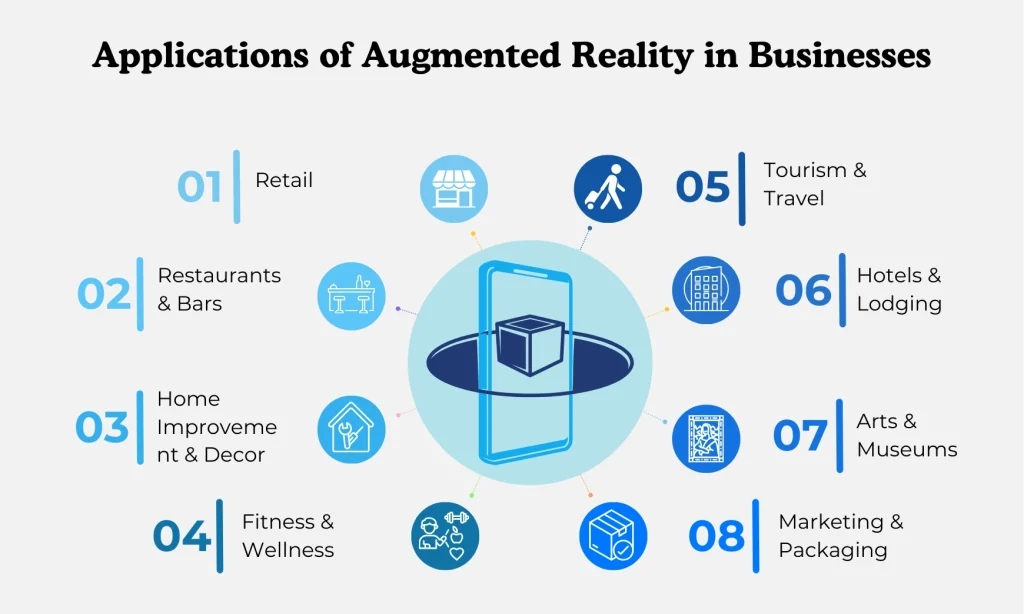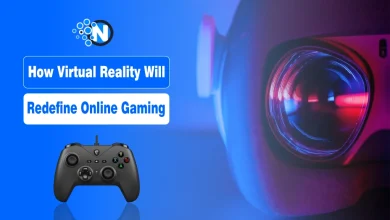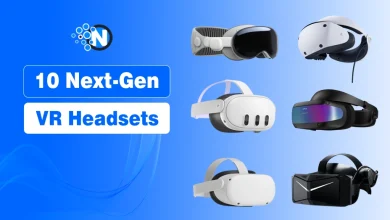Augmented Reality in Businesses – Real-World Applications That Work
A few months ago, I was shopping for a new couch online. You know the struggle – trying to guess if the color will match your walls or if it’ll even fit in your living room.
Then I tripped upon an app that let me place a virtual version of the couch right in my space using Augmented Reality (AR). I could walk around it, see how it looked from different angles, and even swap colors with a tap. It felt like magic!
AR is not a mere futuristic phenomenon but has transformed the manner in which we shop, learn, and conduct business. So, how exactly is AR remodelling industries, and how can companies harness it effectively? Let’s go deeper into its business potential.
<strong>Key AR Business & Impact Statistics</strong>
✅Worldwide revenue for the AR & VR market is projected to reach $46.6 billion in 2025, with a continuous annual growth rate through 2030.
✅Mobile AR market alone is forecasted to grow from $11.9 billion in 2024 to $13.8 billion in 2025, with rapid adoption seen in retail and consumer-facing businesses.
✅McKinsey research highlights that AR is a priority digital transformation area across major industries and is reshaping competitive arenas and driving new revenue streams globally.
✅There is a lot of room for growth in the augmented reality market, which is expected to reach $1,869.40 billion by 2032 from $93.67 billion in 2024.
What is Augmented Reality?
Augmented Reality (AR) is a technology that overlays computer-generated images, information, or 3D objects on real-world environments.
Marketers use augmented reality for engaging marketing campaigns to boost brand awareness. Virtual and interactive mobile apps are two ways it improves the travel industry.
Applications of Augmented Reality in Businesses

1. Retail: Virtual Try-Ons and Product Previews
Retailers, both online and brick-and-mortar are seeing major benefits from AR. Instead of imagining how a couch might fit in a living room or how a pair of glasses might look, customers can “try before they buy” instantly.
- Fashion boutiques use AR mirrors and apps that let shoppers preview outfits without stepping into a fitting room.
- Eyewear shops offer smartphone filters that overlay frames on a customer’s face.
- Home-goods and furniture stores allow buyers to place 3D models of sofas, rugs, or lamps into their own rooms using their phone camera.
These previews eliminate guesswork. AR product visualizers can double browsing time and increase conversions dramatically. Simply put, AR turns window shopping into an engaging, purchase-ready experience.
2. Restaurants & Bars: Interactive Menus and Packaging
Restaurants and food vendors are using AR to make dining more engaging and informative.
- AR Menus: Customers scan a QR code to see a life-size 3D model of dishes on their table before ordering. They can check portion size, ingredients, or even suggested drink pairings. These menus make ordering fun and they also drive upsells.
- Packaging Experiences: Breweries and wineries are turning their bottles into storytelling tools. Scan the label, and customers can see an animated video about how the drink was made or even play a mini tasting game.
AR is also utilized in restaurants as entertainment where children can play AR games in the restaurant when they wait and create a more impressive experience. This is a cost effective method to differentiate and promote word-of-mouth buzz in small food businesses.
3. Home Improvement & Decor: See It Before You Install It
Home centers and interior designers are using AR to help customers visualize renovations. With an AR app, a homeowner can snap a photo of their living room and then tap through samples of paint, tile, or furniture that appear on the walls or floor.
- Paint shops let customers “paint” their walls virtually to test colors.
- Flooring retailers allow shoppers to place different tile or wood options directly onto their kitchen floor.
- Interior designers use AR to preview furniture layouts for clients in real time.
Instead of second-guessing, customers get visual proof. Retailers report higher sales and fewer returns because buyers purchase with confidence. Small home-improvement shops, furniture boutiques, and flooring outlets find AR to be a practical sales closer.
4. Fitness & Wellness: Gamified, Guided Workouts
AR is helping fitness businesses make exercise more engaging and personal. It motivates clients while also improving their form.
- Gamified runs let users race virtual opponents.
- Yoga studios use AR to correct poses in real time.
- Fitness apps add stories (like zombies chasing you) for fun workouts.
- AR coaching ensures safer training without needing constant supervision.
- Wellness tracking: Some AR apps visualize progress like showing a 3D model of how posture or strength improves over time.
Workouts become more fun and personalized, which keeps clients coming back. For small gyms and wellness studios, AR is a way to stand out from generic fitness apps.
5. Tourism & Travel: Immersive Tours and Guides
In the travel industry, AR bridges imagination with reality.
- Virtual previews: Customers can scan a landmark photo and unlock a 3D tour or historical overlay.
- Guided exploration: On trips, AR apps provide real-time overlays of directions, facts, or even hidden “treasures” as tourists walk city streets.
- Gamification: Attractions and parks use AR scavenger hunts (like finding dinosaurs at a museum or in a park) to engage families.
6. Hotels & Lodging: Smarter Guest Experiences
Even small hotels and B&Bs are using AR to attract and delight guests.
- Virtual room tours help travelers book with confidence.
- On-site AR concierge: Guests can point their phone around the room to access info about amenities, dining, or directions to the pool.
- Dining upsells: Hotel restaurants can use AR menus to entice guests with 3D previews of meals.
These tools improve customer satisfaction, reduce repetitive staff inquiries, and drive upsells on extras like spa bookings or dining packages.
7. Arts & Museums: Educational and Interactive Exhibits
Museums and galleries are using AR to make exhibits more engaging:
- Pointing a phone at a painting can trigger an overlay of the artist explaining the work.
- AR can be used by historical museums to provide 3D reconstructions of historic objects or structures.
- Public art and murals can “come alive” with animations when scanned.
Smaller local museums benefit especially: off-the-shelf AR apps let them compete with bigger institutions by offering mesmerizing, educational experiences that appeal to younger audiences.
8. Marketing & Packaging: Turning Ads into Experiences
AR is emerging as an affordable, yet high return, marketing tool amongst small companies.
- Product packaging: A coffee roaster can add a QR code, which opens a 3D story of the origin of the beans.
- Interactive ads: Billboards or flyers can be scanned to play animation or 3D demonstrations of products.
- Customer engagement: Since AR content is new and entertaining, individuals share it on social media, where small businesses are promoted free of charge.
- Event promotion: AR posters can be used at concerts, local markets, or festivals to uncover sneak previews of what is going on or highlights of vendors when scanned.
- Storytelling campaigns: Small brands can use AR to share founder stories, product origins, or behind-the-scenes content that deepens emotional connections.
- In-store activations: Retailers can provide AR treasure hunts or hidden content in-aisle, or make shoppers explore the store further.
AR in a nutshell makes old packaging and print to become interactive, experienceable, and memorable, leading to increased brand recall.
Benefits of AR for Businesses
1. Reduced Returns & Better Purchase Decisions
Virtual try-ons and product previews help customers see how items will look in real life (size, color, style), which lowers the risk of returns. Retailers report fewer returns when AR is used in product visualization.
2. Higher Engagement & Conversion Rates
AR experiences are more immersive and interactive. Companies incorporating AR report significantly higher engagement, users spend more time, interact more, and are likelier to buy.
For example, brands offering AR try-ons or AR storefronts see boosts in product page views and conversion intent.
3. Competitive Differentiation & Brand Loyalty
Using AR helps brands stand out. Early or innovative adopters gain customer attention more easily. It also builds customer loyalty, because customers perceive value in having a richer experience.
4. Better Training, Remote Assistance & Overcoming Skills Gaps
AR is used in industries with frequent upskilling needs, manufacturing, healthcare, field services. It enables immersive, hands-on learning with fewer resources, remote expert support, and real-time guidance. This helps address labor/talent shortages.
5. More Efficient & Agile Product Development
AR lets businesses prototype virtually (e.g. product designs, layout, environment) before physical production or deployment. This reduces cost, time, and waste. User feedback during early AR trials can help tweak designs.
6. Integration with AI/ML to Personalize Experiences
AI is increasingly used to adapt AR content dynamically so that content adapts to user behavior, environment, preferences etc. Personalized AR is leading to more relevant customer interactions.
7. Advancements in Hardware & Infrastructure
More powerful and efficient AR wearables (glasses, headsets) are coming, while improvements in network infrastructure (5G/low latency) are making real-time AR smoother and more reliable.
Conclusion: What Can be The Future
The use of AR technology in business is only going to increase as the technology becomes more accessible and affordable what is still viewed as an experiment today will become a daily tool in the future, and can help small businesses of all types to provide smarter, more immersive, and future-proof customer experiences.
Further, Organizations must also take into account the cost of implementation, barriers to user adoption, the privacy and security of users, and the limitations of the technology available. In case the companies take into consideration the aforementioned factors, the advanced business environment can be easily managed by means of augmented reality (AR).
People Also Ask
What is Augmented Reality (AR) in business?
Augmented Reality (AR) in business refers to using digital overlays, like 3D models, images, or data on real-world environments to enhance customer experiences, training, product visualization, and operational efficiency.
What industries benefit most from AR in 2025?
The biggest adopters are retail, manufacturing, healthcare, marketing, tourism, and education.
Is AR expensive for small businesses to implement?
Yes, the initial investment can be high due to hardware, software, and content development costs.
Can AR work without special headsets or glasses?
Yes. Many AR experiences run directly on smartphones and tablets through apps or web AR.
What role does AR play in marketing campaigns?
AR makes ads interactive, letting customers engage with products in real environments for better marketing insights.





